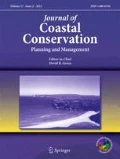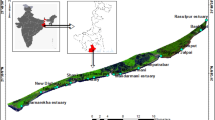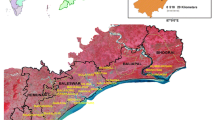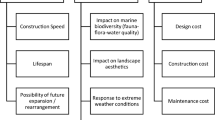Abstract
The present study focuses on the quantification of coastal risks associated with erosion and inundation accelerated by sea level rise and extreme storms events in the specific conditions of micro-tidal semi-enclosed seas. The main objective is to develop a measure that characterises climate-related external hazards, the exposure (of people and assets at risk of being damaged) and vulnerability of human and natural systems. This is accomplished by means of adaption of the concept of nondimensional coastal risk (or resilience) index (CRI), as a function of coastal vulnerability and exposure indices, to the conditions of sedimentary shores of the eastern Baltic Sea and testing its suitability for low-lying coastal zones considering their environmental and socio-economic characteristics. The study area is an about 45 km long coastal section of Lithuania in the south-eastern Baltic Sea. We introduce a set of locally relevant coastal vulnerability and exposure variables, apply an Analytical Hierarchy Process to calculate the criteria weights and GIS multi-criteria evaluation approach to calculate the CRI values. The coastal segments with high vulnerability often have low values of the exposure index. About 11% of the study area is under very high risk. The largest CRI values occur at a certain distance from the touristic or industrial spots near Klaipėda, around the Palanga pier and to the north of Šventoji. These coastal sectors are highly populated areas that suffer from sediments deficit due to coastal engineering structures.






Similar content being viewed by others
References
Alexandersson H, Tuomenvirta H, Schmith T, Iden K (2000) Trends of storms in NW Europe derived from an updated pressure data set. Clim Res 14:71–73
Ashton A, Murrey AB, Arnault O (2001) Formation of coastline features by large-scale instabilities induced by high angle waves. Nature 414:296–300
BACC II [Author Team] (2015) Second assessment of climate change for the Baltic Sea basin. In: Springer international publishing
Bagdanavičiūtė I, Kelpšaitė L, Daunys D (2012) Assessment of shoreline changes along the Lithuanian Baltic Sea coast during the period 1947-2010. Baltica 25:171–184. https://doi.org/10.5200/baltica.2012.25.17
Bagdanavičiūtė I, Kelpšaitė L, Soomere T (2015) Multi-criteria evaluation approach to coastal vulnerability index development in micro-tidal low-lying areas. Ocean Coast Manage 104:124–135. https://doi.org/10.1016/j.ocecoaman.2014.12.011
Baltranaite E, Jurkus E, Povilanskas R (2017) Impact of physical geographical factors on sustainable planning of South Baltic seaside resorts. Baltica 30(2):119–131. https://doi.org/10.5200/baltica.2017.30.13
Bathi JR, Das HS (2016) Vulnerability of coastal communities from storm surge and flood disasters. Int J Env Res Pub He 13(2): Art No 239, https://doi.org/10.3390/ijerph13020239
Benassai G, Di Paola G, Aucelli PPC (2015) Coastal risk assessment of a micro-tidal littoral plain in response to sea level rise. Ocean Coast Manage 104:22–35. https://doi.org/10.1016/j.ocecoaman.2014.11.015
Bitinas A, Žaromskis R, Gulbinskas S, Damušytė A, Žilinskas G, Jarmalavičius D (2005) The results of integrated investigations of the Lithuanian coast of the Baltic Sea: geology, geomorphology, dynamics and human impact. Geol Q 49(4):355–362
Björkqvist JV, Lukas I, Alari V, van Vledder GP, Hulst S, Pettersson H, Behrens A, Männik A (2018) Comparing a 41-year model hindcast with decades of wave measurements from the Baltic Sea. Ocean Eng 152:57–71. https://doi.org/10.1016/j.oceaneng.2018.01.048
Boateng I (2012) GIS assessment of coastal vulnerability to climate change and coastal adaption planning in Vietnam. J Coast Conserv 16:25–36. https://doi.org/10.1007/s11852-011-0165-0
Boruff BJ, Emrich C, Cutter SL (2005) Erosion hazard vulnerability of US coastal counties. J Coastal Res 21(5):932–942
Dailidienė I, Tilickis B, Stankevičius A (2004) General peculiarities of long-term fluctuations of the Baltic Sea and the Kurshiu Marios lagoon water level in the region of Lithuania. Environmental research, engineering and management. Technologija 4(30):3–10
Dailidienė I, Davulienė L, Stankevičius A, Myrberg K (2006) Sea level variability at the Lithuanian coast of the Baltic Sea. Boreal Environ Res 11(2):109–121
Darwin RF, Tol RSJ (2011) Estimates of the economic effects of sea level rise. Environ Resour Econ 19:113–129. https://doi.org/10.1023/A:1011136417375
Davidson-Arnott RGD (2010) Introduction to Coastal Processes and Geomorphology. Dissertation, University of Cambridge.
Dean RG, Dalrymple RA (2002) Coastal processes with engineering applications. Cambridge University Press, Cambridge
Devoy RJN (2008) Coastal vulnerability and the implications of sea-level rise for Ireland. J Coast Res 24(2):325–341
Doukakis E (2005) Coastal vulnerability and risk parameters. EurWater 11(12):3–7
Dubra V (2006) Influence of hydrotechnical structures on the dynamics of sandy shores: the case of Palanga on the Baltic coast. Baltica 19(1):3–9
Dubra V, Grecevičius P, Dubra J (2011) Current changes of sandy seashore of Lithuania within the impact of natural and anthropogenic processes. Littoral 2010 – Adapting to Global Change at the Coast: Leadership, Innovation, and Investment 06006: 1–11. https://doi.org/10.1051/litt/201106006
Eidikonienė J, Žilinskas G (2011a) Poilsiautojų srauto sklaida Klaipėdos rekreacinėje zonoje. Geografija 47(1):30–37 (in Lithuanian)
Eidikonienė J, Žilinskas G (2011b) Poilsiautojų srauto sklaida Šventosios rekreacinėje zonoje. Geografija 47(2):117–124 (in Lithuanian)
Ernsteins R, Lontone-Ievina A, Lagzdina E, Osniece K, Kaulins J (2017) Integrated coastal management practice case studies: deficiency of collaboration communication and socio-ecological system approaches. In: Auzina a (ed), integrated and sustainable regional development marketing and sustainable consumption. Econ Sci Rural Dev45:63–70
Fletcher CH., Romine BM, Genz AS, Barbee MM, Dyer M, Anderson TR, Lim SC, Vitousek S, Bochicchio Ch, Richmond BM (2012) National assessment of shoreline change: Historical shoreline change in the Hawaiian Islands: U.S. Geological Survey Open-File Report 2011–1051
Furmanczyk KK, Dudzinska-Nowak J (2009) Effects of extreme storm on coastline changes: a South Baltic example. J Coast Res SI 56:1637–1640
Getis A, Ord JK (1992) The analysis of spatial association by use of distance statistics. Geogr Anal 24
Gornitz VM, White TW (1992) A coastal hazards database for the U.S. West Coast: ORNL/CDIAC-81, NDP-043C, Oak Ridge National Laboratory, Oak Ridge, Tenn. http://cdiac.ornl.gov/epubs/ndp/ndp043c/43c.htm
Gornitz VM, Daniels RC, White TW, Birdwell KR (1994) The development of a coastal vulnerability assessment database, vulnerability to sea-level rise in the U.S. southeast. J Coast Res SI (12): 327–338. https://www.jstor.org/stable/25735608. Accessed 8 May 2017
Gudelis V (1998) Offshore and nearshore of Lithuania. Vilnius (in Lithuanian)
Hallegatte S, Green C, Nicholls RJ, Corfee-Morlot J (2013) Future flood losses in major coastal cities. Nat Clim Chang 3:802–806
Hapke CJ, Himmelstoss EA, Kratzmann M, List JH, Thieler ER (2010) National Assessment of shoreline change; historical shoreline change along the New England and mid-Atlantic coasts. Open File Rep U S Geol Surv 2010–1118
Hünicke B, Zorita E, Soomere T, Madsen KS, Johansson M, Suursaar Ü (2015) Recent change – sea level and wind waves. In: The BACC II author team, second assessment of climate change for the Baltic Sea basin. Springer, pp 155–185
IPCC 2014: Climate change 2014: impacts, adaptation, and vulnerability. Summaries, frequently asked questions, and cross-chapter boxes. A contribution of working group II to the fifth assessment report of the intergovernmental panel on climate change [field, C.B., V.R. Barros, D.J. Dokken, K.J. Mach, M.D. Mastrandrea, T.E. Bilir, M. Chatterjee, K.L. Ebi, Y.O. Estrada, R.C. Genova, B. Girma, E.S. Kissel, A.N. Levy, S. MacCracken, P.R. Mastrandrea, and L.L. White (eds.)]. World Meteorological Organization, Geneva
Jarmalavičius D, Satkūnas J, Žilinskas G, Pupienis D (2012) Dynamics of beaches of Lithuanian coast (the Baltic Sea) for the period 1993-2008 based on morfometric indicators. Environ Earth Sci 65(6):1727–1736
Jarmalavičius D, Žilinskas G, Pupienis D (2013) Observation on the interplay of sea level rise and the coastal dynamics of the Curonian spit. Geologija 55(2):50–61
Jarmalavičius D, Šmatas V, Stankunavičius G, Pupienis D, Žilinskas G (2016) Factors controlling coastal erosion during storm events. J Coast Res SI 75:1112–1116
Kartau K, Soomere T, Tõnisson H (2011) Quantification of sediment loss from semi-sheltered beaches: a case study of Valgerand Beach, Pärnu Bay The Baltic Sea, J Coast Res SI 64: 100–104
Kelpšaitė L, Dailidienė I (2011) Influence of wind wave climate change to the coastal processes in the eastern part of the Baltic proper. J Coast Res SI 64: 220–224
Kunte PD, Jauhari N, Mehrotra U, Kotha M, Hursthouse AS, Gagnon AS (2014) Multi-hazards coastal vulnerability assessment of Goa, India, using geospatial techniques. Ocean Coast Manage 95:264–281
Lapinskis J (2017) Coastal sediment balance in the eastern part of the Gulf of Riga (2005–2016). Baltica 30(2):87–95. https://doi.org/10.5200/baltica.2017.30.10
Le Cozannet G, Garcin M, Bulteau T, Mirgon C, Yates ML, Mendez M, Baills A, Idier D, Oliveros C (2013) An AHP-derived method for mapping the physical vulnerability of coastal areas at regional scales. Nat Hazards Earth Syst Sci 13:1209–1227
Lins-de-Barros FM (2017) Integrated coastal vulnerability assessment: a methodology for coastal cities management integrating socioeconomic, physical and environmental dimensions – case study of Região dos Lagos, Rio de Janeiro. Brazil Ocean Coast Manage 149:1–11. https://doi.org/10.1016/j.ocecoaman.2017.09.007
Malczewski J (1999) GIS and multicriteria decision analysis. John Wiley and Sons, New York
Malczewski J (2000) On the use of weighted linear combination method in GIS: common and best practice approaches. Trans GIS 4:5–22. https://doi.org/10.1111/1467-9671.00035
Mani Murali R, Ankita M, Amrita S, Vethamony P (2013) Coastal vulnerability assessment of Puducherry coast, India, using the analytical hierarchical process. Nat Hazards Earth Syst Sci 13(12):3291–3311
McLaughlin S, Cooper JAG (2010) A multi-scale coastal vulnerability index: a tool for coastal managers? Environ Hazards 9:233–248. https://doi.org/10.3763/ehaz.2010.0052
McLaughlin S, McKenna J, Cooper JAG (2002) Socio-economic data in coastal vulnerability indices: constraints and opportunities. J Coast Res SI 36: 487–497
Mėžinė J, Zemlys P, Gulbinskas S (2013) A coupled model of wave-driven erosion for the Palanga Beach, Lithuania. Baltica 26(2):169–176
Mitchell A (2005) The ESRI guide to GIS analysis 2. ESRI Press, Redlands, California
Mosadeghi R, Tomlinson R, Mirfenderesk H, Warnken J (2009) Coastal management issues in Queensland and application of the multi-criteria decision making techniques. J Coast Res SI 56: 1252–1256
Nageswara Rao K,Subraelu P, Venkateswara Rao T, Hema Malini B, Ratheesh R, Bhattacharya S, Rajawat Ajai AS (2008) Sea-level rise and coastal vulnerability: an assessment of Andhra Pradesh coast. India J Coast Conserv 12:195–207. https://doi.org/10.1007/s11852-009-0042-2
Nicholls RJ, Hanson SE, Lowe JA, Warrick RA, Lu X, Long AJ (2014) Sea-level scenarios for evaluating coastal impacts. WIREs Clim Change 5:129–150
Oropeza-Orozco O, Sommer-Cervantes I, Carlos-Gomez J, Preciado-Lopez JC, Ortiz-Perez MA, Lopez-Portillo J (2011) Assessment of vulnerability and integrated management of coastal dunes in Veracruz, Mexico. Coast Manage 39(5):492–514
Orviku K, Jaagus J, Kont A, Ratas U, Rivis R (2003) Increasing activity of coastal processes associated with climate change in Estonia. J. Coast Res 19:364–375
Peña-Alonso C, Hernández-Calvento L, Pérez-Chacón E, Ariza-Solé E (2017) The relationship between heritage, recreational quality and geomorphological vulnerability in the coastal zone: a case study of beach systems in the Canary Islands. Ecol Indic 82:420–432. https://doi.org/10.1016/j.ecolind.2017.07.014
Pendleton EA, Hammar-Klose ES, Thieler ER, Williams SJ (2004) Coastal vulnerability assessment of Cumberland Island National Park to sea-level rise. Open File Rep U S Geol Surv 2004–1021. http://pubs.usgs.gov/of/2004/1196/index.html. Accessed 4 Sept 2017
Pindsoo K, Soomere T (2015) Contribution of wave set-up into the total water level in the Tallinn area. Proc Estonian Acad Sciences 64(3S):338–348. https://doi.org/10.3176/proc.2015.3S.03.
Povilanskas R, Armaitiene A, Dyack B, Jurkus E (2016) Islands of prescription and islands of negotiation. J Destin Market Manage 5(3):260–274. https://doi.org/10.1016/j.jdmm.2016.01.004
Pranzini E, Williams A (2013) Coastal Erosion and protection in Europe. Taylor and Francis, Abingdon-NewYork, Routledge
Pupienis D, Jarmalavičius D, Žilinskas G, Fedorovič J (2014) Beach nourishment experiment in Palanga, Lithuania. J Coast Res SI 70:490–495
Pycroft J, Abrell J, Ciscar JC (2016) The global impacts of extreme sea-level rise: a comprehensive economic assessment. Environ Resour Econ 64:225–253. https://doi.org/10.1007/s10640-014-9866-9
Qin WM, Lin AW, Fang J, Wang LC, Li M (2017) Spatial and temporal evolution of community resilience to natural hazards in the coastal areas of China. Nat Hazards 89(1):331–349. https://doi.org/10.1007/s11069-017-2967-3
Ramieri E, Hartley A, Barbanti A, Duarte-Santos F, Gomes A, Hilden M, Laihonen P, Marinova N, Santini M (2011) Methods for assessing coastal vulnerability to climate change. ETC CCA Technical Paper 1/2011
Saaty TL (1980) The analytic hierarchy process. McGraw-Hill, New York
Saaty TL (1996) Multicriteria decision-making: the analytic hierarchy process. RWS Publications, Pittsburgh
Sahin O, Mohamed S (2013) A spatial temporal decision framework for adaptation to sea level rise. Environ Model Softw 46:129–141
Salas-Olmedo MH, García-Palomares JC, Gutierrez J (2018) Tourists’ digital footprint in cities: comparing big data sources. Tourism Manage 66: 13–25. https://doi.org/10.1016/j.tourman.2017.11.001.
Satta A, Snoussi M, Puddu M, Flayou L, Hout R (2016) An index-based method to assess risks of climate-related hazards in coastal zones: the case of Tetouan. Estuar Coast Shelf Sci 175:93–105. https://doi.org/10.1016/j.ecss.2016.03.021
Satta A, Puddu M, Venturini S, Giupponi C (2017) Assessment of coastal risks to climate change related impacts at the regional scale: the case of the Mediterranean region. Int J Disaster Risk Reduct 24:284–296. https://doi.org/10.1016/j.ijdrr.2017.06.018
Seifert TF, Tauber B, Kayser B (2001) A high resolution spherical grid topography of the Baltic Sea. In: Baltic Sea Science Congress, second ed. Poster 147, Stockholm http://www.io-warnemuende.de/iowtopo
Silva SF, Martinho M, Capitão R, Reis T, Fortes CJ, Ferreira JC (2017) An index-based method for coastal-flood risk assessment in low-lying areas (Costa de Caparica, Portugal). Ocean Coast Manage 144:90–104. https://doi.org/10.1016/j.ocecoaman.2017.04.010
Soomere T, Healy T (2011) On the dynamics of “almost equilibrium” beaches in semi-sheltered bays along the southern coast of the Gulf of Finland. In: Harff J, Bjorck S, Hoth P (eds) The Baltic Sea basin. Springer, Berlin, Heidelberg
Soomere T, Pindsoo K (2016) Spatial variability in the trends in extreme storm surges and weekly-scale high water levels in the eastern Baltic Sea. Cont Shelf Res 115:53–64
Soomere T, Räämet A (2014) Decadal changes in the Baltic Sea wave heights. J Mar Syst 129:86–95. https://doi.org/10.1016/j.jmarsys.2013.03.009
Soomere T, Viška M (2014) Simulated sediment transport along the eastern coast of the Baltic Sea. J Mar Syst 129:96–105
Stottrup JG, Dinesen GE, Janssen H, Gillgren C, Schernewski G (2017) Re-visiting ICM theory and practice: lessons learned from the Baltic Sea region. Ocean Coast Manage 139:64–76. https://doi.org/10.1016/j.ocecoaman.2017.02.002
Szlafsztein C, Sterr H (2007) A GIS-based vulnerability assessment of coastal natural hazards, state of Pará, Brazil. J Coast Conserv 11(1):53–66
Thieler ER, Himmelstoss EA, Zichichi JL, Ergul A (2009) Digital shoreline analysis system (DSAS) version version 4.0 - An ArcGIS extension for calculating shoreline change. Open File Rep U S Geol Surv 2008–1278. http://pubs.usgs.gov/of/2008/1278. Accessed 13 Sept 2017
Tibbetts JR, van Proosdij D (2013) Development of a relative coastal vulnerability index in a macro-tidal environment for climate change adaptation. J Coast Conserv 17(4):775–797
Valdmann A, Kaard A, Kelpšaitė L, Kurennoy D, Soomere T (2008) Marine coastal hazards for the eastern coasts of the Baltic Sea. Baltica 21(1–2):3–12
Viška M, Soomere T (2013) Simulated and observed reversals of wave-driven alongshore sediment transport at the eastern Baltic Sea coast. Baltica 26 (2):145-156
Wang GH, Liu YJ, Wang HB, Wang XY (2014) A comprehensive risk analysis of coastal zones in China. Estuar Coast Shelf Sci 140:22–31
Woodruff S, Vitro KA, BenDor TK (2018) GIS and coastal vulnerability to climate change. Compr Geogr Inf Syst:236–257. https://doi.org/10.1016/B978-0-12-409548-9.09655-X
Zeidler RB (1997) Continental shorelines: climate change and integrated coastal management. Ocean Coast Manage 37(1):41–62
Zhamoida VA, Ryabchuk DV, Kropatchev YP, Kurennoy D, Boldyrev VL, Sivkov VV (2011) Recent sedimentation processes in the coastal zone of the Curonian spit (Kaliningrad region, Baltic Sea). Z Dtsch Ges Geowiss 160(2):143–157. https://doi.org/10.1127/1860-1804/2009/0160-0143
Žilinskas G (2005) Trends in dynamic processes along the Lithuanian Baltic coast. Acta Zoologica Lituanica 15(2):204–207
Žilinskas G (2008) Distinguishing priority sectors for the Lithuanian Baltic Sea coastal management. Baltica 21(1–2):85–94
Žilinskas G, Eidikonienė J (2012) Poilsiautojų srauto sklaida Palangos rekreacinėje zonoje. Geografija 48:55–66
Žilinskas G, Jarmalavičius D (1996) Estimation of vulnerability of Lithuanian Baltic Sea coasts on the background of Baltic Sea water level rise. Geografijos Metraštis 29:147–183 (in Lithuanian)
Žilinskas G, Jarmalavičius D (2007) Interrelation of morphometric parameters of the submarine shore slope of the Curonian spit. Lithuania Baltica 20(1–2):46–52
Žilinskas G, Jarmalavičius D, Kulvičienė G (2000) Hurricane „Anatolij“ impact to the Lithuanian Sea coast. Geografijos Metraštis 33: 191–206 (in Lithuanian)
Acknowledgements
The study was partly funded by European Commission within the framework of the Interreg South Baltic programme 2014–2020 and The Reviving Baltic Resilience project (STHB.02.02.00-22-0092/16). The cartographic data was kindly provided by National Land Service of Lithuania and Lithuanian Geological Survey. The interpretation of the data was supported by the institutional financing by the Estonian Ministry of Education and Research (Estonian Research Council grant IUT33-3). The authors are grateful to two anonymous reviewers for their valuable comments.
Author information
Authors and Affiliations
Corresponding author
Rights and permissions
About this article
Cite this article
Bagdanavičiūtė, I., Kelpšaitė-Rimkienė, L., Galinienė, J. et al. Index based multi-criteria approach to coastal risk assesment. J Coast Conserv 23, 785–800 (2019). https://doi.org/10.1007/s11852-018-0638-5
Received:
Revised:
Accepted:
Published:
Issue Date:
DOI: https://doi.org/10.1007/s11852-018-0638-5




